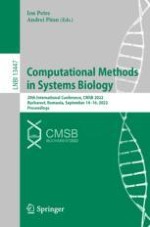2022 | OriginalPaper | Buchkapitel
Minimal Trap Spaces of Logical Models are Maximal Siphons of Their Petri Net Encoding
verfasst von : Van-Giang Trinh, Belaid Benhamou, Kunihiko Hiraishi, Sylvain Soliman
Erschienen in: Computational Methods in Systems Biology
Aktivieren Sie unsere intelligente Suche, um passende Fachinhalte oder Patente zu finden.
Wählen Sie Textabschnitte aus um mit Künstlicher Intelligenz passenden Patente zu finden. powered by
Markieren Sie Textabschnitte, um KI-gestützt weitere passende Inhalte zu finden. powered by
